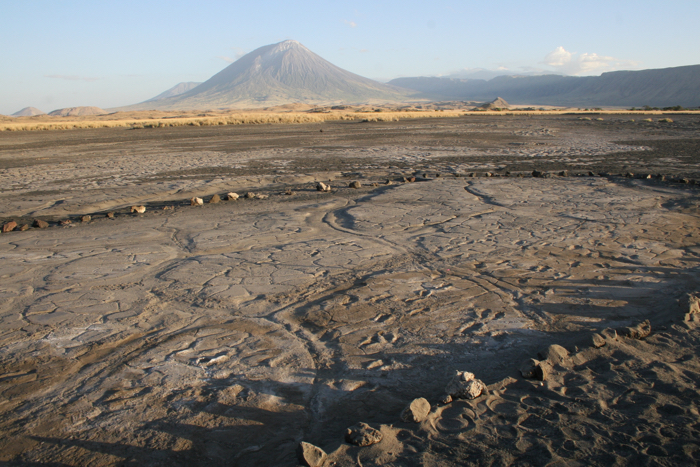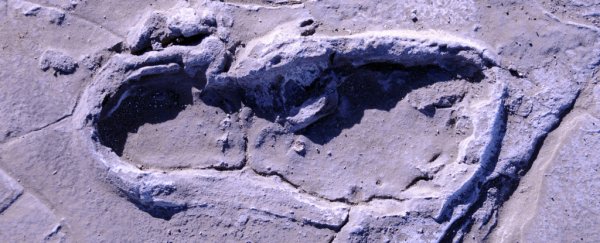Thousands of years ago, Ol Doinyo Lengai let forth. This unique Tanzanian volcano – 'Mountain of God', in the tongue of the local Masaii people – erupted on an unknown day in prehistory, sending a deluge of ash and lava down its sacred slopes.
The molten mass, carrying soil and mixing with floodwater from a nearby lake, produced a thick layer of impressionable mud that came to rest on the plains below. A short time later, before the cement-like sludge had a chance to harden, a tribe strode through the nascent mud flat, leaving a record of hundreds of fossilised human footprints that can still be seen to this day.
That hypothetical sequence of events – which might have looked something like this – is scientists' best explanation for what created the largest assemblage of ancient hominin tracks ever found in Africa, known as the Engare Sero footprints.
 The Engare Sero footprint site, in front of the Ol Doinyo Lengai volcano. (Cynthia Liutkus-Pierce)
The Engare Sero footprint site, in front of the Ol Doinyo Lengai volcano. (Cynthia Liutkus-Pierce)
In a new study led by human evolutionary biologist Kevin Hatala from Chatham University in Pittsburgh, researchers examined these prehistoric impressions, to see what we could find out about the humans who made them in the mud millennia ago.
The tracks – first discovered by a local villager, before coming to the attention of researchers in 2008 – are estimated to be somewhere between 5,760 to 19,100 years old, according to previous research.
Earlier speculation that the tracks might be much older, dating to 120,000 years back – has since been constrained by newer investigations.
In any case, what makes Engare Sero special isn't so much its age; for that, the nearby Laetoli tracks, about 100 kilometres (60 miles) away, take the cake – representing what most researchers accept as the oldest footprints on the planet that can be attributed to early hominins, at around 3.7 million years old.
Rather, what sets Engare Sero apart is the vastness of its collection of preserved tracks: 408 footprints in total, left behind by a large group of individuals. Who were these ancient Africans, and what were they doing as they crossed the plains so long ago?
Of course, we will never be able to comprehend the full scope of their lives and long-gone culture, but it's amazing what scientists can in fact capture, reconstructing details of this vanished community from the way they walked thousands of years in the past.
Hatala and his team say all of the footprints were left by barefoot humans, given individual toe impressions are easily distinguishable in the tracks.
Amongst the footprints, 17 sets of tracks look like they were created by individuals at moderate walking speed, likely representing a group that was moving together in unison in a southwesterly direction.
In this group, it's thought that 14 of the individuals were adult females, together with two adult males and one young male.
Another set of six individuals left tracks moving in the opposite direction, and displaying a range of movement speeds, with at least two suggestive of fast walking, and one set of prints being left by a running individual.
Due to the difference in speeds in that set moving northeasterly, the researchers suggest it's unlikely that those six people were travelling together.
While we can't be entirely sure why the composition of the track-makers overall was primarily adult females, the researchers suggest a cooperative foraging activity could be a plausible hypothesis for the tracks we can still see.
"Modern human foragers are unique among primates in that they typically forage together, and in that they typically divide labour between the sexes," the authors explain in their paper.
"In modern human groups such as the Ache and Hadza, groups of adult females will cooperatively forage, with occasional visits or accompaniment from adult males."
That could explain the Engare Sero footprints, the researchers say, which also don't seem to include any tracks made by children – something that wouldn't be surprising if this area was mainly used for food-gathering purposes performed by older people.
"Aside from nursing infants (who are likely to be carried), children are typically excluded from these types of group foraging activities and left behind in camp," the team writes.
The findings are reported in Nature.
